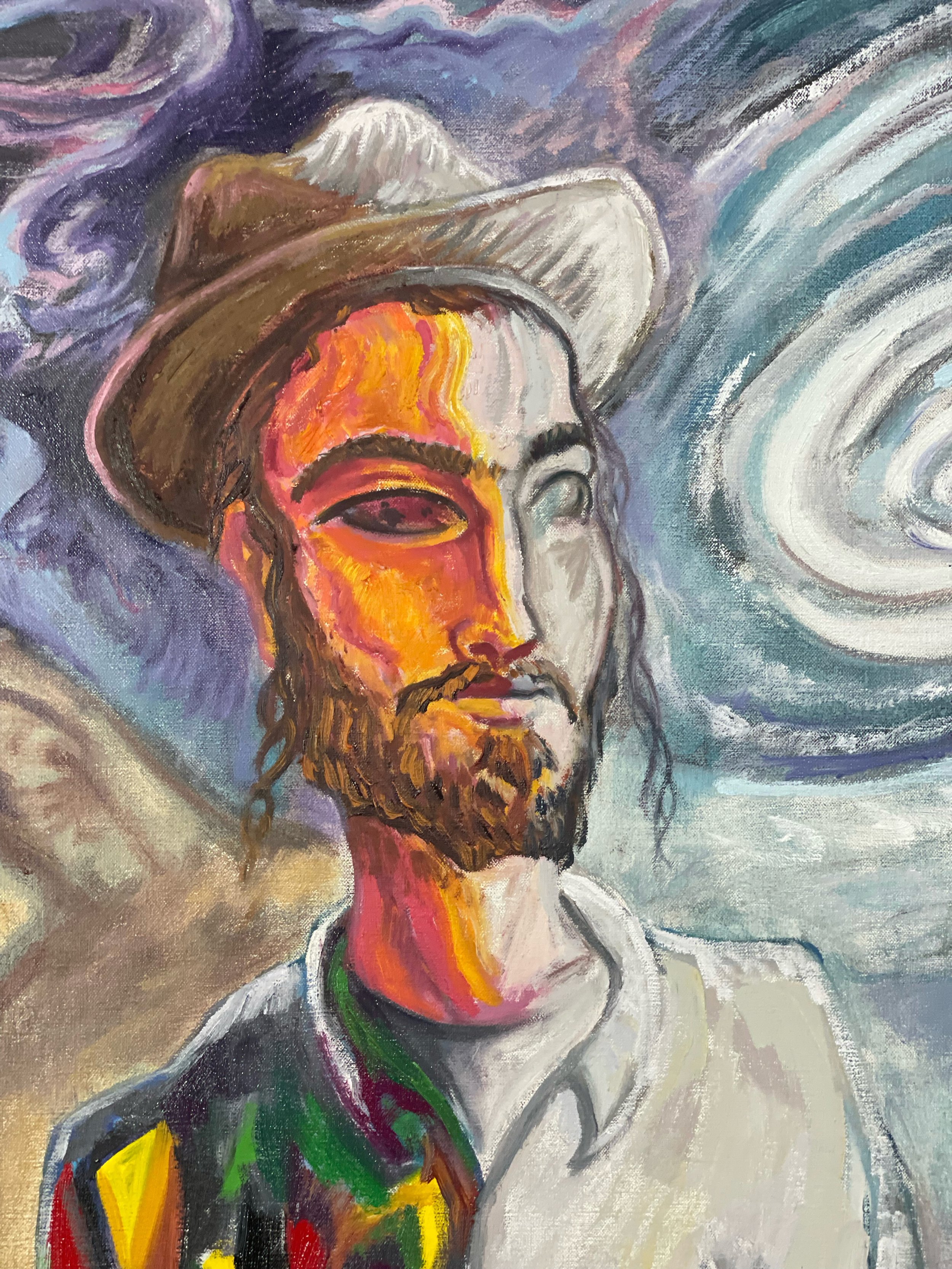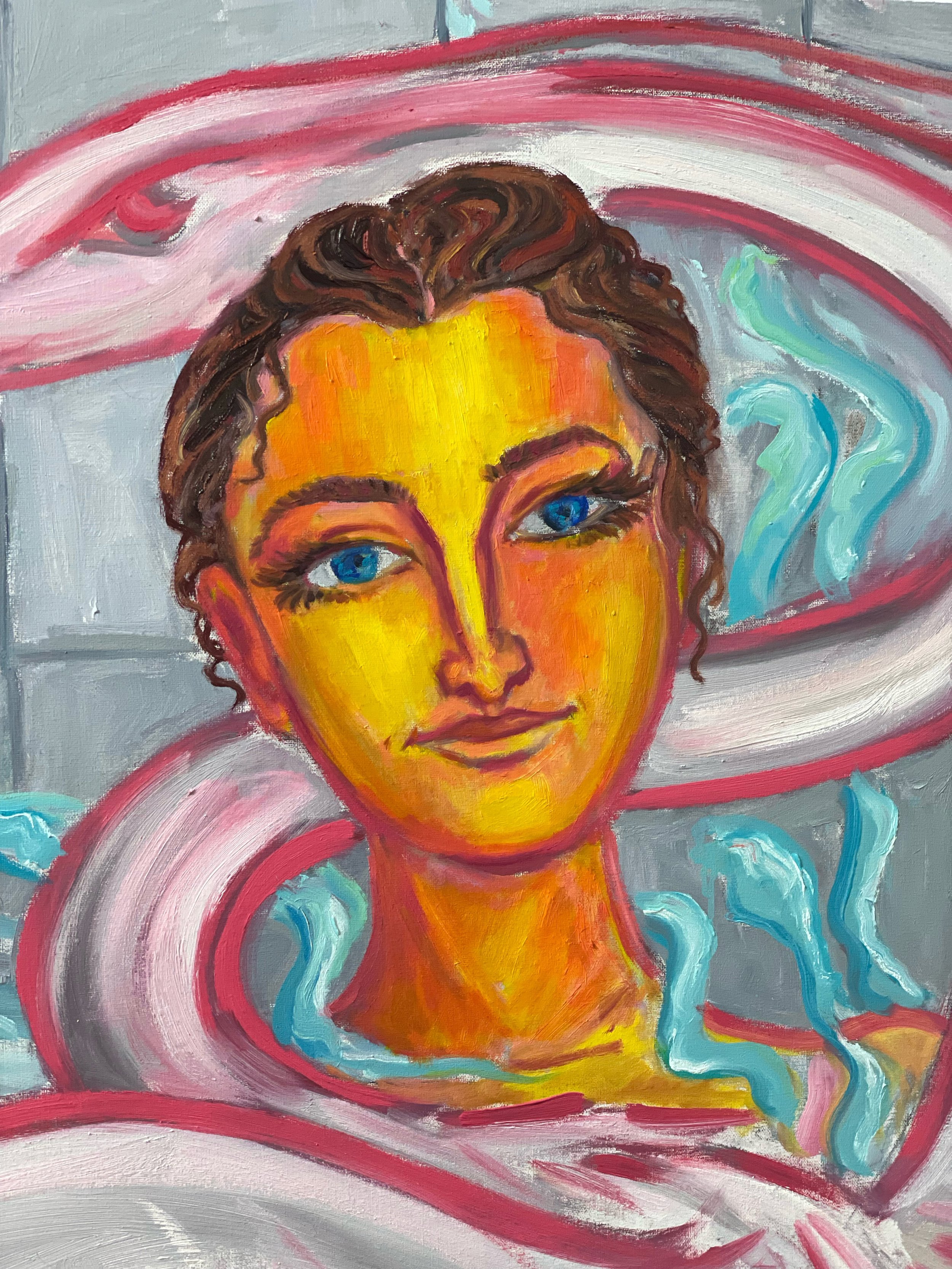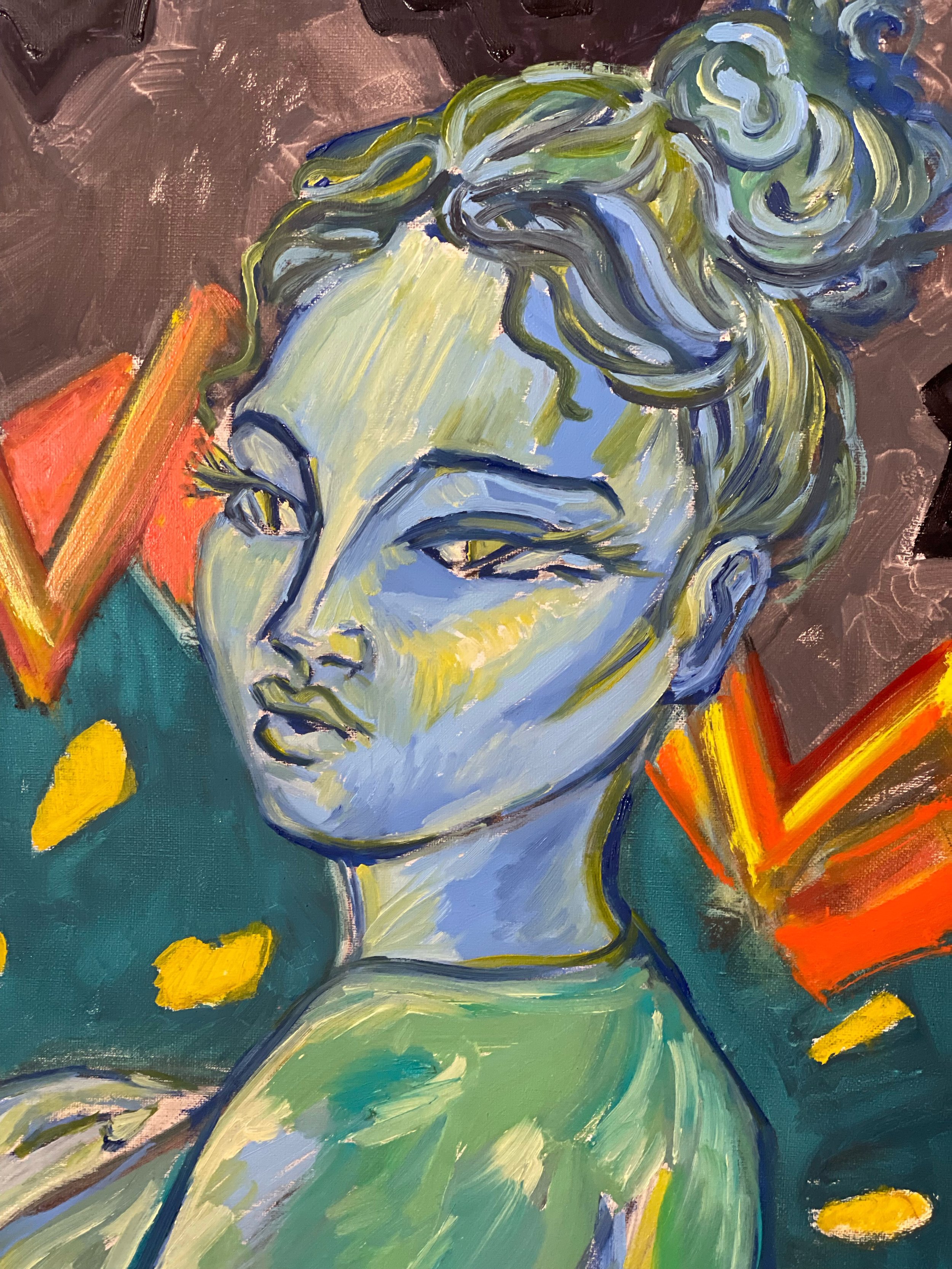A Heroic Sort of Journey with the Recovery of the Feminine,
by Samuel Abelow. Edited by Johannes Böckmann.
I have felt a sense of chaos and disorder and pain in my life. I produce talismans to help myself with this. These images harness emotion and bring coherence to my fragmented sense of world and self. Today, after many years of working with symbolic images, I have obtained a more clear sense of self – recognizing my Jewish ancestry and ethnic identity. Art is my way of communicating: I want to help transform and develop our collective conversations and impact individual lives, which are interconnected through culture.
This is why for many years now I have been searching in my painting for a way to represent the masculine and feminine — represented by the male and female — as well as many other dimensions of personality. I’ve experienced these dualities, with many nuances, as contained within my personality, and witnessed expressions of this symbolic wholeness in others.
While working on an update of my archive & current portfolio sections of this website, my studio manager and friend Johannes Böckmann and I were brainstorming what to title previous bodies of work. It occurred to Böckmann that Joseph Cambell’s concept of the Hero’s Journey might be helpful. I was struck by a chart of the archetypal storyline which is used in theater and film classrooms. But these sorts of mass cultural associations to Cambell’s synthesis never interested me much. But, lo and behold, this simple theater chart summarizes my artistic process, which has coincided with my own Jungian analysis over the past 6-10 years, or so.
“In the Shadow of the Mother Complex”, oil paint on canvas (Neo-Expressionist style). Samuel Abelow, 2017.
When I look back at my art, between 2016 and 2018 there is the theme of recovering the feminine and a whole self from amidst a feminine mystery. A stand-out motif is a struggling black woman. Along with this was myself represented with a shaved head, near to the Great Mother, or at least longing, tired, alone.
Looking at the Artist
The source of the Character Arc chart at hand is not known to me, but I will work with it creatively now. If we begin “ACT I” with the earliest works available in the archive — 2017 — there is a beginning of an art practice. I titled this page “ARTISTÉ” to refer to the closed-in, sort of naive conception of being an artist — as if it was the 1890s, or 1920s.
The small canvases of a male and female figure, representing Jung’s concept of Eros & Logos, which Böckmann collected (pictured installed in his apartment), represent this initial stage of increased awareness:
Behold! The opposites capture my attention: I want to understand the male & female, the masculine & feminine.
The interest in the constituents of personality is there, but the imaginal world is timeless, composed with extensive references to Gauguin, Van Gogh and Picasso, as well as Renoir, Da Vinci, and other historic arts of exotic cultures like Japan. I was attempting to digest and work through a whole slew of material.
My Reluctance to Change is exemplified by both the “Still Life With Horse” and “Encounter With the Hawk.” The aesthetic ideology — system of organizing a painting — are decidedly Symbolist. I was reluctant to invent, unleash or dare. My own individual artistic identity had not formed; I was working as-if I was Gauguin; it is a way forward, but not yet authentically “me.” That said, I still like the painting, though.
The Overcoming is fulfilled in “Tending the House Plants,” which, although lacking a high standard of formal completion, broke free in terms of brushwork and color usage, as well as a more liberated approach to the canvas. This is because I engaged with the work without as much control, by way of preliminary drawings, planning, grids or transfers. My father, David Abelow, who studied art and architecture at Cooper Union, specifically encouraged this shift and that was helpful towards generating the emotional strength to break free of the Symbolist ideology. This encouragement from my father, I am still thankful for.
Experimenting With Our Origins
Although works from 2017 are a bit rigid, alongside a fittingly retrograde Van Gogh-Gauguin persona, I did work to overcome my own self-restrictive and backward-looking tendencies, urged by a desire to protect against change (both in the studio and in life) as a defense against a sense of world as dangerous
It is “Encounter With the Mysteries of the Feminine” — lush, dynamic highly erotic — that leads into a series of dark, dreamy, eerie and honest windows in the glamor and terror of the collective unconscious. This is the pivotal moment of Committing. For, if I was naive before, I was daring now.
“Have You Seen Hades By the Rocky Outcrop? (Persephone Encounters Hades)” is the primary outcome of this headlong dive into darkness. The Symbolist techniques are still visible, but adventurous brushwork and strange color choices are now feeding the canvas with emotional and magical qualities which had hitherto been rare. Additionally, the subject matter shows a commitment to artistic vision, without concern for politic, critic or audience.
Moving into Act II, there is this Experimenting & Preparing for a Big Change. Although at the time I considered that my work beginning in late 2018 and into 2019 was elevated to a stage of greatness — looking back at this period, I was more or less building up to a more original thesis backed by a mature understanding of self, world and psyche, in relationship to production of art.
ORIGINS was a prolonged project. The body of works that primarily fit into this period of Experimentation are “In the Garden” and “The Story of Persephone.” Within the adolescent blues, pinks, yellow and use of ample white (pastels), was a search for more clarity around the soul-image, or anima — the feminine counterpart of a man. I was very serious about this, attending analysis studiously and carefully archiving my artworks.
“Orphic Dance” (Detail). Version, 2018.
“All of this must’ve been a preparation for something!”
In late 2018, when I first painted the “Orphic Dance” (now the “Poet-Singer Dance”), I knew, in an instant, there had been a dramatic change: it was my confidence and daring to approach the six foot canvas without any crutches or supports (transfers, grids) — as well as the clarity of vision and emotional intensity. This original canvas is no-longer shown on my website. It featured full frontal male nudity, as symbolic of lower-phallic energy. The consequences of this was a provocative show curated by Timothy Hull at the college gallery he runs in the Hudson Valley.
Today, I am stronger, more masculine, with a beard and hair; and I don’t paint this erotic eve, or this ethnic sorcerer, or else myself as this decrepit, weak boy, serious and sorrowful; now I associate the self to images such as Adam Kadmon – an aspiration of completion – or represent other men as whole individuals, with autonomy and spiritual strength. My women are as diverse as ever, but specific— asian, indigenous, African, Jewish, Colombian, etc. Each portrait of a woman — whether a modern sex worker or biblical matriarch— has a name, a personality, and clothing.
Finally Arrived, for Now
That is where ACT III begins: a Rededication. Looking back, I see some powerful attempts — attempts which lean heavily on historic modes of organizing paintings, on other people like Betty Woodman or Matisse/Picasso.
I have seen: My life & soul is that of the Jewish exile, as much as the African diaspora. That is: my mother (Mimi) and my nanny (Jackie). My art is her recovery — a sensitivity to her suffering — and the assertion [hope for and belief in] of a potential unity. This unity was prefigured in the abstract paintings, which demonstrate an enigmatic pleroma, and then later, mandala-like revolving forms.
As much as the feminine — as domain of experience, and personification of soul — was and always is the black woman, early on and today, it has also developed in the image of the jewish woman as my feminine counterpart.
So, 2017-2020 amounts of a backdrop, a series of acts in a story — heroic because at times dangerous and often painful. But this story is incomplete, ongoing as I now acknowledge modernity, and therefore the relativity of my work. Still, this all leads me to further my attempt to clarify the vision and communicate images of renewal – for the collective healing and restoration of the feminine, and a mature masculine which can support and live in harmony with the beauty and essence of life. This is my resolution for 2022.








![Jewel of My Heart (Encounter) [Detail]](https://images.squarespace-cdn.com/content/v1/52cc712be4b02afbed71e235/1642696407886-97GZ4YKLGXYO955W9DG2/Nechama-detail.jpg)
![Sheba (The Shulamite) [Detail]](https://images.squarespace-cdn.com/content/v1/52cc712be4b02afbed71e235/1642696408780-DUFJWS5S8YB8GOZVS37Y/sheba-detail.jpg)